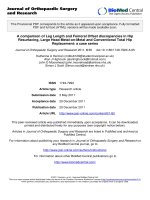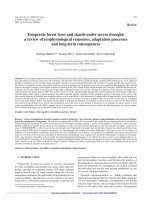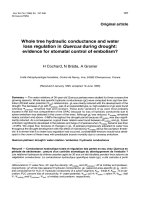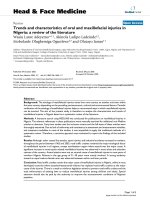Conceptualizing the organization of surgical services; comment on “decentralization and regionalization of surgical care a review of evidence for the optimal distribution of surgical services in low and middle incom
Bạn đang xem bản rút gọn của tài liệu. Xem và tải ngay bản đầy đủ của tài liệu tại đây (304.16 KB, 3 trang )
Int J Health Policy Manag 2021, 10(4), 218–220
doi 10.34172/ijhpm.2020.60
Commentary
Conceptualizing the Organization of Surgical Services
Comment on “Decentralization and Regionalization of Surgical Care: A Review of Evidence
for the Optimal Distribution of Surgical Services in Low- and Middle-Income Countries”
Sara A. Kreindler*
ID
Abstract
According to Iverson and colleagues’ thoughtful analysis, decisions to decentralize or regionalize surgical services
must take into account contextual realities that may impede the safe execution of certain delivery models in lowand middle-income countries (LMICs), and should be governed by procedure-related considerations (specifically,
volume, patient acuity, and procedure complexity). This commentary suggests that, by shifting attention to the
mechanisms whereby (de)centralization may exert beneficial impacts, it is possible to generate guidance applicable
to countries across the socioeconomic spectrum. Four key mechanisms can be identified: decentralization (1)
minimizes the need for patients to travel for care and, (2) obviates certain system-induced delays once patients
present; centralization (3) facilitates the maintenance of a workforce with sufficient expertise to offer services safely,
and (4) conserves resources by limiting the number of sites. The commentary elucidates how context- and procedurerelated factors determine the importance of each mechanism, allowing planners to prioritize among them. Although
some context factors have special relevance to LMICs, most can also appear in high-income countries (HICs), and
the procedure-related factors are universal. Thus, evidence from countries at all income levels might be fruitfully
combined into an integrated body of context-sensitive guidance.
Keywords: Surgery, Service Delivery, Regionalization, Decentralization, Low- And Middle-Income Countries
(LMICs)
Copyright: © 2021 The Author(s); Published by Kerman University of Medical Sciences. This is an open-access
article distributed under the terms of the Creative Commons Attribution License ( />licenses/by/4.0), which permits unrestricted use, distribution, and reproduction in any medium, provided the
original work is properly cited.
Citation: Kreindler SA. Conceptualizing the organization of surgical services: Comment on “Decentralization and
regionalization of surgical care: a review of evidence for the optimal distribution of surgical services in low- and
middle-income countries.” Int J Health Policy Manag. 2021;10(4):218–220. doi:10.34172/ijhpm.2020.60
I
verson and colleagues’ thorough review yields valuable
guidance to countries seeking to optimize the organization
of surgical services while working within resource
constraints.1 The authors make a convincing argument that
decisions to centralize or decentralize the delivery of a certain
type of surgery should be informed by three considerations:
the volume of patients, the acuity of the condition requiring
surgery, and the complexity of the procedure. Another
way to conceptualize the findings would be to understand
centralization and decentralization as having distinct
mechanisms of benefit, which are differentially important
for different types of surgery and in different contexts. An
advantage of this more abstract approach is that it allows the
development of guidelines applicable to countries across the
socioeconomic spectrum.
This commentary seeks to make explicit the key mechanisms
whereby each model of service delivery can improve patient
and system outcomes. I would suggest that it is possible
to account for the review findings by positing just four
mechanisms, two per model. Specifically, decentralization
(1) minimizes the need for patients to travel for care and (2)
obviates certain system-induced delays once patients present,
while centralization (3) facilitates the maintenance of a
Article History:
Received: 22 November 2019
Accepted: 19 April 2020
ePublished: 29 April 2020
*Correspondence to:
Sara A. Kreindler
Email:
workforce with sufficient expertise to offer services safely and
(4) conserves resources by limiting the number of sites. As
each model is associated with unique mechanisms of benefit,
health systems face inevitable trade-offs. Fortunately, however,
not all mechanisms are equally important for every procedure
or in every context. By analyzing procedure and context
factors in terms of their influence on the importance of each
mechanism, it is possible to generate an integrated framework
to govern decisions about service organization. Below I will
attempt such an analysis, drawing on Iverson and colleagues’
findings from low- and middle-income countries (LMICs)
alongside some evidence from high-income countries (HICs).
Models of Service Organization and Their Mechanisms
Mechanism 1: Decentralization minimizes the need for
patients to travel for care, allowing them to access services
more quickly, conveniently, and inexpensively. Mechanism 1
seems key to the authors’ conclusion that decentralization is
optimal for the treatment of high-acuity conditions (as travel
time can delay care, putting patients at risk) and for highvolume procedures (as it is inefficient that large numbers of
patients be required to travel). It also seems highly applicable
to preventative services (which patients may choose not to
Department of Community Health Sciences, Rady Faculty of Health Sciences, University of Manitoba, Winnipeg, MB, Canada.
Kreindler
access unless it is convenient to do so) and to services that
demand comprehensiveness and continuity (eg, primary care,
community-based care for chronic conditions), both of which
the authors mention as potential domains for decentralization.1
Mechanism 1 would seem most relevant in contexts where the
distances involved are large (ie, less so when centralization is
a matter of reducing the number of facilities within the same
city),2,3 transportation is difficult to access, and/or patients
can ill afford the financial burden of travel.1 These contextual
factors have obvious relevance to LMICs, but are also relevant
to large HICs with remote communities.
Mechanism 2: Decentralization obviates certain systeminduced delays that can occur after patients present, such as
delays in transporting patients from outlying facilities to the
appropriate referral centre. Like Mechanism 1, Mechanism 2
is most relevant to high-acuity and high-volume procedures,
for the reasons of risk and inefficiency described above. It is
most likely to apply in contexts where referral, transportation,
communication and/or information systems are weak –
hence, in LMICs.1 However, it is important to note that HICs
are not immune to the problem of system-induced delay:
In one Canadian study of the consolidation of acute-care
surgery, patients who happened to present to a non-referral
hospital waited significantly longer for their procedures.4 As
the need for acute-care surgery, unlike some types of surgical
need, may not be readily apparent, it may be difficult to
ensure that patients present to the most appropriate site under
a centralized system. Thus, one might add “easily diagnosed”
to the list of characteristics of a surgical disease that make
Mechanism 2 particularly relevant.
Mechanism 3: Centralization facilitates the maintenance of
a workforce with sufficient expertise to offer services safely.
This is not only because centralized models require fewer
providers (making them easier to staff) but because they afford
surgeons the opportunity to perform an adequate volume of
each type of surgery to maintain their expertise.5 Mechanism
3 is key to the authors’ conclusion that centralization is most
appropriate for procedures of low volume (least opportunity
for regular practice) and high complexity (greatest need
for expertise).1 Given the difficulty of establishing precise
thresholds for volume–outcome relationships5 planners
have some leeway to define “adequate volume,” and those in
resource-limited contexts may choose a more liberal definition
in order to balance the risk of inadequate volume against
other risks. Planners in such settings are also more likely to
explore the potential of task transfer to non-surgeons, which
brings its own set of considerations about the development
and maintenance of expertise.1 Nonetheless, Mechanism 3 in
and of itself is important in LMICs as well as HICs.
Mechanism 4: Centralization conserves resources by
limiting the number of sites that a system must maintain.
(It might be noted that centralization and decentralization
can have different resource implications depending on their
specific features, such as the extent to which decentralization
includes task transfer; all things being equal, however,
centralized models should be less resource-intensive).
Systems may be forced to centralize services in response to
a shortage of surgeons (which frequently occurs in LMICs,
as the authors note,1 but can also occur in HICs4), or may
actively pursue economies of scale, including those associated
with the creation of highly efficient centres for specialized,
low-variability procedures (more likely to be undertaken
in HICs).6 Resource constraints are, of course, more severe
in LMICs; however, they may be a major motivator for
centralization in HICs as well.2
It may also be useful to consider these mechanisms in
light of the population–capacity–process model of service
design.7 This model holds that, in order to design services
that are well-aligned with population needs, planners must
clearly define all populations in need of care and link each
to appropriate capacity through an efficient process. We
can observe that the mechanisms of decentralization are
concerned with optimizing process (linking patients to care in
as streamlined a way as possible), while those of centralization
are concerned with optimizing capacity (ensuring the right
type and quantity of resources, including providers, to meet
patient needs). Although Mechanism 2 is also relevant to
questions of population definition, as in the acute-care
surgery example,4 most surgical populations are relatively
easy to define. Thus, decisions to decentralize or centralize
services typically involve a trade-off between optimizing
process and optimizing capacity.
If decentralization is adopted to optimize process,
alternative strategies may be required to ensure suitable
capacity; as the authors note, workforce training is typically
required, a single period of which may not suffice.1
Conversely, colleagues’ centralization is adopted to optimize
capacity, alternative strategies may be required to compensate
for process challenges. Mobile surgical camps may represent
a means of ensuring local access to high-complexity (though
not high-acuity) procedures; more broadly, centralization
may necessitate major investments in referral, transportation
and communication infrastructure.1 Early in the article, the
authors raise the question of whether such investments would
yield greater returns than the decentralization of services;
through no fault of their own, they are unable to answer this
question with the available data. However, it seems clear that
all models of organizing services have some risks, whose
mitigation might require a significant outlay of resources.
Discussion
As the authors suggest, the “ideal distribution of services”
is both procedure-specific and context-specific. Procedure
factors determine the relative advantage of more rapid arrival
vs. more expert provider – the former being most important
for high-acuity surgery, the latter for low-volume and highcomplexity surgery. Context affects the system’s ability to
realize any of the mechanisms safely, through either service
reorganization or alternative strategies. Thus, although
the four identified mechanisms are relevant to both HICs
and LMICs, context should shape decisions about which
mechanism(s) to prioritize and how to operationalize them.
The premise underlying the authors’ undertaking to derive
LMIC-specific recommendations is that evidence drawn from
HIC-based studies may yield conclusions that are unsuitable
for LMICs.1 At several junctures, the authors draw particular
International Journal of Health Policy and Management, 2021, 10(4), 218–220
219
Kreindler
attention to the risks of centralization for LMICs that may
not have the resources to execute it safely. Although none of
the available studies of regionalization in LMICs uncovered
adverse outcomes, such a concern remains legitimate:
LMICs may, as a result of population characteristics and/or
infrastructural limitations, be particularly vulnerable to the
risks of regionalization. Nonetheless, rather than maintain
two different sets of recommendations, it might be ideal to
develop an integrated body of context-sensitive guidance,
informed by findings from both LMICs and HICs. After
all, all of the procedure-related and many of the contextrelated considerations identified through this review can also
be relevant in HICs. Furthermore, the evidence regarding
regionalization of surgical services in HICs is not monolithic;
although centralization may be widely viewed as best practice,
its impacts appear to vary by procedure and setting.3,4,8-10
The authors’ nuanced examination of evidence from LMICs
reminds us how crucial it is that recommendations take
adequate account of context. Perhaps guidance directed at
health systems in general should look more like that offered
by the authors1 – that is, perhaps what should be promoted is
not a model of service delivery but rather a set of principles and
considerations for choosing a model. Such an approach could
potentially enrich decision-making in HICs and LMICs alike.
Acknowledgements
I am grateful to Reena Kreindler for her editorial advice.
Ethical issues
Not applicable.
Competing interests
Author’s contribution
SAK is the single author of the paper.
References
1.
2.
3.
4.
5.
6.
7.
8.
9.
10.
Iverson KR, Svensson E, Sonderman K, et al. Decentralization and
regionalization of surgical care: a review of evidence for the optimal
distribution of surgical services in low- and middle-income countries.
Int J Health Policy Manag. 2019;8(9):521-537. doi:10.15171/
ijhpm.2019.43
Hamilton SM, Johnston WC, Voaklander DC. Outcomes after the
regionalization of major surgical procedures in the Alberta Capital
Health Region (Edmonton). Can J Surg. 2001;44(1):51-58.
Kreindler SA, Siragusa L, Bohm E, Rudnick W, Metge CJ. Regional
consolidation of orthopedic surgery: impacts on hip fracture surgery
access and outcomes. Can J Surg. 2017;60(5):349-354. doi:10.1503/
cjs.000517
Kreindler SA, Zhang L, Metge CJ, et al. Impact of a regional acute
care surgery model on patient access and outcomes. Can J Surg.
2013;56(5):318-324. doi:10.1503/cjs.007012
Amato L, Fusco D, Acampora A, et al. Volume and health outcomes:
evidence from systematic reviews and from evaluation of Italian hospital
data. Epidemiol Prev. 2017;41(5-6 suppl 2):1-128. doi:10.19191/
ep17.5-6s2.p001.100
Christensen CM, Grossman JH, Hwang J. The Innovator’s Prescription:
A Disruptive Solution for Healthcare. New York: McGraw-Hill; 2009.
Kreindler SA. Six ways not to improve patient flow: a qualitative study.
BMJ Qual Saf. 2017;26(5):388-394. doi:10.1136/bmjqs-2016-005438
Celso B, Tepas J, Langland-Orban B, et al. A systematic review and
meta-analysis comparing outcome of severely injured patients treated
in trauma centers following the establishment of trauma systems. J
Trauma. 2006;60(2):371-378. doi:10.1097/01.ta.0000197916.99629.
eb
Chang V, Blackwell RH, Yau RM, et al. Variable surgical outcomes
after hospital consolidation: implications for local health care delivery.
Surgery. 2016;160(5):1155-1161. doi:10.1016/j.surg.2016.05.027
Diaz JJ Jr, Norris PR, Gunter OL, Collier BR, Riordan WP, Morris JA
Jr. Does regionalization of acute care surgery decrease mortality? J
Trauma. 2011;71(2):442-446. doi:10.1097/TA.0b013e3182281fa2
Author declares that she has no competing interests.
220
International Journal of Health Policy and Management, 2021, 10(4), 218–220









